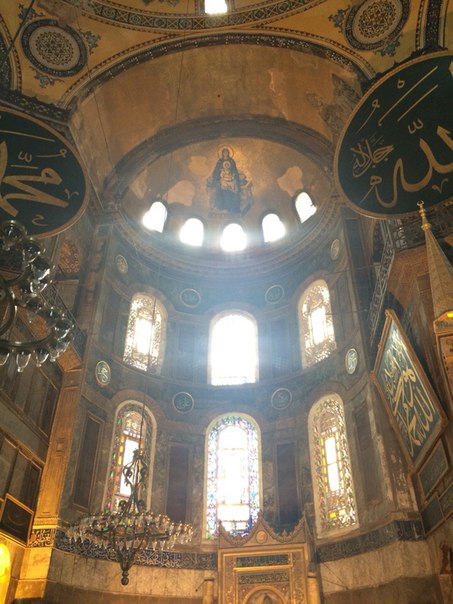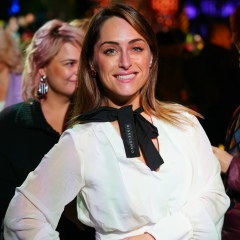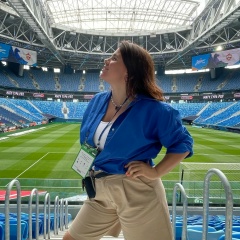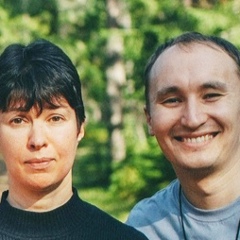Путевые заметки невесты
День 8. Стамбул
Стамбул - столица двух империй и... Турции)) Кто бы что бы ни говорил здесь о Европе, Стамбул совершенно восточный город с соответствующим колоритом из суеты и толкотни, своеобразных запахов рынка, криков торговцев и пестроты их лавок. Византинисты, наверное, мысленно уже закидывают меня камнями, но я соглашусь с теми, кто считает этот город грязным, тесным для 18 миллионов местных, и тем более для толп туристов, и небезопасным в плане дорог и трафика.
Открытие 1. Из действительно интересного - базилика-цистерна под землей, построенная древними римлянами для хранения воды. Вода прозрачная, и в ней плавают рыбы.
Открытие 2. Древний храм Св Софии действительно красив только внутри. Огромный купол опирается на арки и распадается на полукупола, которые опираются на арки и распадаются на три маленьких четверть купола каждый. Стены, своды и купол пробиты окнами с цветным стеклом и покрыты золотыми мозаиками. В целом такое ощущение, будто находишься внутри огромной золотой мембраны и сверху льется золотистый свет. Медальоны с арабской вязью на стенах смотрятся в этом великолепии как здоровые черные кляксы.
Открытие 3. Есть в Стамбуле здание покрасивей Св.Софии. Это Голубая мечеть. Она меньше размером, но сходна по структуре. Если в Софии массивы четырех главных опор ощутимы, то здесь в мембране растворились и они. Если в Софии светится только центральное пространство, а галереи за опорами сильно затенены, то здесь затененных мест нет. Огромная куполообразная светящаяся со всех сторон бело-голубая мембрана с немыслимо большим количеством окон с цветными витражами. Если Бог это свет, то Голубая мечеть это наиболее точное архитектурное выражение этой идеи. Ни пятикупольные православные соборы, ни итальянские мраморные шедевры, ни готические громады, ни витражи часовни Сен Шапель не давали мне такого волшебного ощущения божественного света. Только ради одного этого стоило приехать в Стамбул.
День 8. Стамбул
Стамбул - столица двух империй и... Турции)) Кто бы что бы ни говорил здесь о Европе, Стамбул совершенно восточный город с соответствующим колоритом из суеты и толкотни, своеобразных запахов рынка, криков торговцев и пестроты их лавок. Византинисты, наверное, мысленно уже закидывают меня камнями, но я соглашусь с теми, кто считает этот город грязным, тесным для 18 миллионов местных, и тем более для толп туристов, и небезопасным в плане дорог и трафика.
Открытие 1. Из действительно интересного - базилика-цистерна под землей, построенная древними римлянами для хранения воды. Вода прозрачная, и в ней плавают рыбы.
Открытие 2. Древний храм Св Софии действительно красив только внутри. Огромный купол опирается на арки и распадается на полукупола, которые опираются на арки и распадаются на три маленьких четверть купола каждый. Стены, своды и купол пробиты окнами с цветным стеклом и покрыты золотыми мозаиками. В целом такое ощущение, будто находишься внутри огромной золотой мембраны и сверху льется золотистый свет. Медальоны с арабской вязью на стенах смотрятся в этом великолепии как здоровые черные кляксы.
Открытие 3. Есть в Стамбуле здание покрасивей Св.Софии. Это Голубая мечеть. Она меньше размером, но сходна по структуре. Если в Софии массивы четырех главных опор ощутимы, то здесь в мембране растворились и они. Если в Софии светится только центральное пространство, а галереи за опорами сильно затенены, то здесь затененных мест нет. Огромная куполообразная светящаяся со всех сторон бело-голубая мембрана с немыслимо большим количеством окон с цветными витражами. Если Бог это свет, то Голубая мечеть это наиболее точное архитектурное выражение этой идеи. Ни пятикупольные православные соборы, ни итальянские мраморные шедевры, ни готические громады, ни витражи часовни Сен Шапель не давали мне такого волшебного ощущения божественного света. Только ради одного этого стоило приехать в Стамбул.
Travel notes of the bride
Day 8. Istanbul
Istanbul is the capital of two empires and ... Turkey)) Whoever speaks of Europe here, Istanbul is an absolutely eastern city with a corresponding flavor from the hustle and bustle, the peculiar smells of the market, the screams of merchants and the diversity of their shops. Byzantinists probably already mentally throw stones at me, but I agree with those who consider this city dirty, cramped for 18 million local people, and especially for crowds of tourists, and unsafe in terms of roads and traffic.
Discovery 1. Of the really interesting - the underground basilica-cistern, built by the ancient Romans to store water. The water is clear and fish swim in it.
Opening 2. The ancient church of St. Sophia is really beautiful only inside. The huge dome rests on arches and breaks up into half domes, which rest on arches and fall into three small quarter domes each. The walls, arches and dome are punched by stained-glass windows and covered with golden mosaics. In general, it feels like you are inside a huge golden membrane and golden light is pouring from above. Medallions with Arabic script on the walls look in this splendor like healthy black blots.
Opening 3. There is a building in Istanbul that is more beautiful than St. Sophia. This is the Blue Mosque. It is smaller in size, but similar in structure. If in Sofia the arrays of the four main supports are palpable, then here they are also dissolved in the membrane. If in Sofia only the central space shines, and the galleries behind the poles are very shaded, then there are no shaded places. A huge domed white-blue membrane shining from all sides with an incredibly large number of windows with colored stained-glass windows. If God is light, then the Blue Mosque is the most accurate architectural expression of this idea. Neither five-domed Orthodox cathedrals, nor Italian marble masterpieces, nor Gothic bulks, nor the stained glass windows of the chapel of Saint Chapelle gave me such a magical sensation of divine light. For the sake of this alone, it was worth coming to Istanbul.
Day 8. Istanbul
Istanbul is the capital of two empires and ... Turkey)) Whoever speaks of Europe here, Istanbul is an absolutely eastern city with a corresponding flavor from the hustle and bustle, the peculiar smells of the market, the screams of merchants and the diversity of their shops. Byzantinists probably already mentally throw stones at me, but I agree with those who consider this city dirty, cramped for 18 million local people, and especially for crowds of tourists, and unsafe in terms of roads and traffic.
Discovery 1. Of the really interesting - the underground basilica-cistern, built by the ancient Romans to store water. The water is clear and fish swim in it.
Opening 2. The ancient church of St. Sophia is really beautiful only inside. The huge dome rests on arches and breaks up into half domes, which rest on arches and fall into three small quarter domes each. The walls, arches and dome are punched by stained-glass windows and covered with golden mosaics. In general, it feels like you are inside a huge golden membrane and golden light is pouring from above. Medallions with Arabic script on the walls look in this splendor like healthy black blots.
Opening 3. There is a building in Istanbul that is more beautiful than St. Sophia. This is the Blue Mosque. It is smaller in size, but similar in structure. If in Sofia the arrays of the four main supports are palpable, then here they are also dissolved in the membrane. If in Sofia only the central space shines, and the galleries behind the poles are very shaded, then there are no shaded places. A huge domed white-blue membrane shining from all sides with an incredibly large number of windows with colored stained-glass windows. If God is light, then the Blue Mosque is the most accurate architectural expression of this idea. Neither five-domed Orthodox cathedrals, nor Italian marble masterpieces, nor Gothic bulks, nor the stained glass windows of the chapel of Saint Chapelle gave me such a magical sensation of divine light. For the sake of this alone, it was worth coming to Istanbul.




У записи 6 лайков,
0 репостов.
0 репостов.
Эту запись оставил(а) на своей стене Эльмира Ахмерова


























